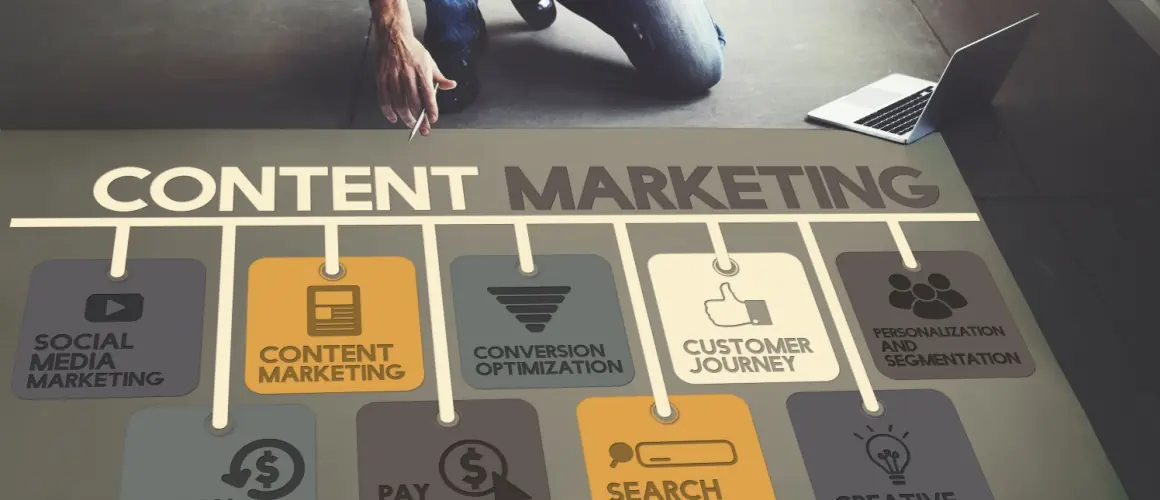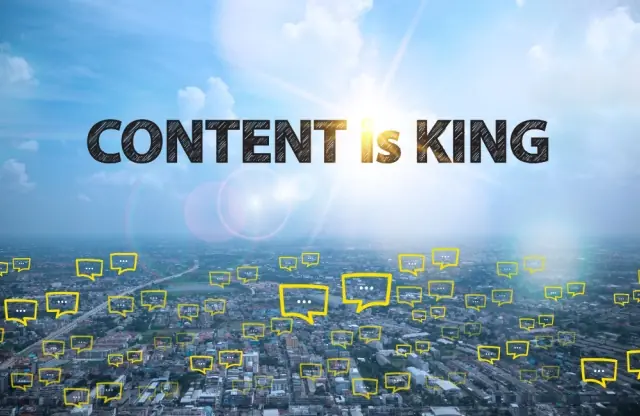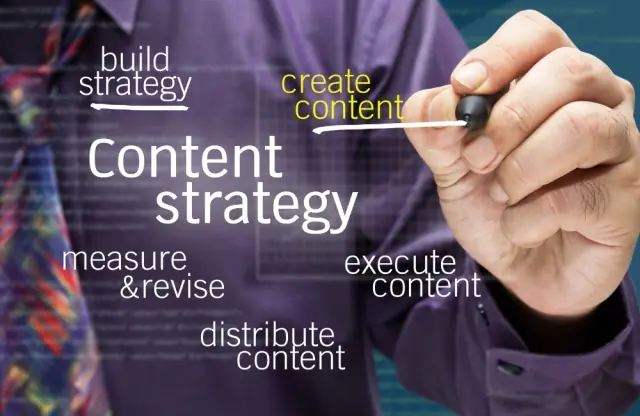
In today’s digital world, a content marketing strategy, or content strategy, is essential. It’s a must for any brand that wants to succeed. This strategy helps you create content. It guides your content marketing efforts. It ensures you reach your target audience effectively. By grasping the essence of content marketing, you can connect with potential customers. This connection is key to making an impact in the digital realm. Our article will dive deep into content creation. We’ll show you the steps to craft a content marketing strategy that speaks to your audience.
Why is a content marketing strategy critical for your brand? We’ll answer this question. We’ll look at the components of a successful content strategy plan. It’s more than publishing content randomly. It’s about creating messages that truly engage and inspire your audience. We’ll teach you how to assemble a content marketing strategy. This strategy will not only reach but also motivate your audience to act. From planning to implementation, we’re here to help. Follow our step-by-step guide to develop a content marketing strategy. In turn, you’ll be able to customize it to fit your brand’s unique needs and objectives.

What Is a Content Marketing Strategy?
A content marketing strategy is a plan, or a framework, for how you’ll use content to reach and engage your target audience. This strategy helps you create high-quality content that resonates with people. It’s not just about making content; it’s about making the right content. Your content marketing strategy guides your content creation. It ensures your content marketing efforts are focused and effective. To create a content marketing strategy, you think about what your audience needs. Then, you plan how to meet those needs with your published content. This strategy is key to connecting with your audience and achieving your goals. Every piece of content should help build that connection. That’s what a content marketing strategy is all about.

10 Reasons You Need a Content Marketing Plan
Creating a strong content marketing strategy or plan is key for businesses in the digital age. Here’s a detailed look at ten reasons why such a strategy is vital for any business:
1. Drive Brand Awareness
High-quality content boosts your brand’s visibility. By producing valuable content consistently, you make potential customers aware of your brand. This increases the chances they’ll choose your products or services.
2. Establish Experience, Expertise, Trust, and Authority
Use case studies, guides, and informative content related to your business to showcase knowledge and expertise. This builds trust with your target audience and establishes your brand’s authority.
3. Enhanced Search Engine Rankings
Updated, informative content can boost your search engine rankings. Optimizing content for search engines and covering topics in-depth establish topical authority. This benefits your audience and your search visibility.
4. Nurturing Your Audience
Content marketing guides prospects through their buyer’s journey. By providing relevant content at each step, you build trust. This prepares your audience to make informed purchasing decisions.
5. Cost-effective Lead Generation
Content marketing is affordable and generates more leads than traditional methods. It’s crucial for small businesses looking to grow their brand and sales.
6. Showcase Subject Matter Expertise
Educational and informative content demonstrates your industry knowledge. This helps potential customers make educated decisions and increases the chances they’ll choose your business.
7. Build Relationships with Customers
Great content strengthens the bond with your existing customers. It encourages repeat business and turns them into brand advocates. This is key for long-term growth and customer retention.
8. Understand Your Ideal Customer
Analytics and data provide insights into your audience’s preferences and behaviors. This allows you to tailor your content strategy effectively.
9. Strengthen Customer Relationships
Content marketing enhances relationships with current customers. Engaged and satisfied customers are more likely to make repeat purchases and advocate for your brand.
10. Differentiation from Competitors
Content marketing helps businesses stand out in a crowded market. Showcasing what makes your business unique helps you attract customers even if there are many options available.
Crafting a content marketing strategy isn’t a box to check off. It’s about forging genuine connections with the people who come across your brand. Think of it as laying down the groundwork for your brand’s reputation in your industry. Plus, it’s a big player in pushing your business forward. Whether you’re looking to draw in new faces, keep current leads interested, or make existing customers feel valued, having a plan for your content is crucial. Every piece of your content strategy has a role, steering your business toward success, one step at a time.

Types of Content in a Content Marketing Strategy
When planning a content marketing strategy, it’s essential to understand the variety of content types available and how you can utilize them to meet your content goals. Each type of content serves unique purposes in engaging your target audience and guiding them through the customer journey. Here’s a closer look at the different types of content you might include in your strategy:
1. Blog Posts
Blog posts are foundational elements in a content marketing strategy. They provide valuable information and help establish authority in your industry. Blogs are excellent for driving organic traffic to your website and improving SEO. You can use them to address common questions, explain complex topics, or share industry insights.
2. Infographics
Infographics are visual content that presents information or data in an engaging, digestible format. They are great for summarizing research, highlighting statistics, or explaining processes in a visually appealing way. Infographics are highly shareable on social media and can help boost engagement.
3. Videos
Video content is one of the most engaging types of content. Whether it’s tutorials, behind-the-scenes looks, or customer testimonials, videos can capture the attention of your audience more effectively than most other types of content. They are particularly useful for demonstrating product uses or services and enhancing customer understanding and connection.
4. eBooks
eBooks are detailed, long-form content that offers comprehensive coverage of a specific topic. They are excellent for gathering leads as they are often exchanged for a user’s contact information. eBooks help in positioning your brand as an expert and are a key tool in nurturing leads along the buyer’s journey.
5. Social Media Posts
Social media posts are essential for engaging with your audience. You can use them to share news, quick tips, or updates about your business. Each platform offers different formats and audiences, making it crucial to tailor your content accordingly to maximize reach and engagement.
6. Case Studies
Case studies are in-depth profiles of how your company’s product or service has successfully helped a customer. They are powerful in demonstrating the value of your offer and building credibility by showcasing real-world applications and results.
7. Podcasts
Podcasts are audio content that allows for deep dives into various topics. They are a way to reach audiences who prefer audio over text and can be consumed on the go. Podcasts are effective for building a personal connection with listeners and can enhance brand loyalty.
8. Newsletters
Email newsletters keep your audience informed about the latest news, tips, or updates from your brand. They help keep your audience engaged over time, providing consistent value that helps strengthen brand loyalty and customer retention.
9. Whitepapers
Whitepapers are detailed reports that are designed to fully inform the reader about a specific topic, often to guide a decision-making process. They are more formal and are typically used in B2B marketing to generate leads and establish thought leadership.
Each type of content plays a strategic role in a content marketing strategy, helping to build content that resonates with your audience at different stages of their journey. By carefully selecting and tailoring these content types to meet your specific content strategy, you can effectively engage your target audience and achieve your business objectives. Remember to schedule these varied content types using a content calendar to ensure a consistent and balanced approach to your content marketing efforts.

9 Steps to Creating a Successful Content Marketing Strategy
Developing a content marketing strategy is crucial for anyone starting out with content marketing. Here’s a detailed explanation of the steps necessary to create a content strategy that aligns with your business goals and engages your target audience effectively:
1. Establish Clear Objectives
Before diving into content creation, set clear, measurable goals. These goals could range from increasing brand awareness to boosting sales. Setting objectives early helps steer your content marketing efforts in the right direction.
2. Know Your Audience
Understanding who you are creating content for is essential. Research your audience’s preferences, challenges, and behaviors. This knowledge ensures the content you create resonates well with the people you aim to reach.
3. Select Appropriate Content Types
Choose the types of content that will best communicate your message to your audience. This might include blogs, video content, infographics, or podcasts. Each content format has its strengths and is effective at different stages of the digital marketing funnel.
4. Generate Relevant Topic Ideas
Brainstorm topics that are relevant to your audience. Look for subjects that not only interest them but also provide value. This could be through educational content, how-to guides, or industry insights.
5. Prioritize High-Potential Topics
Identify topics with the highest potential for impact based on your content goals and audience needs. Focus on these to maximize engagement and effectiveness.
6. Organize With a Content Calendar
Create a content calendar to schedule your posts and ensure consistent content delivery. This tool helps you plan your content strategy over time, track your content production, and maintain regular contact with your audience.
7. Promote Your Content Across Channels
Once your content is ready, promote it through various channels such as social media, email newsletters, or paid ads. Effective promotion increases visibility and helps you reach a larger segment of your target audience.
8. Track and Analyze Performance
Monitor how your content performs by using analytics tools. Tracking engagement rates, click-through rates, and conversions helps you understand what works and what doesn’t. This data is crucial for refining future content and strategies.
9.Implement Content Governance
Create a content governance model to manage how content is created, approved, published, and maintained. This helps ensure that all content aligns with your brand’s voice and complies with regulatory standards, maintaining a consistent quality across all platforms.
A well-executed content marketing strategy involves careful planning and execution. By following these steps to a winning content strategy, you can create meaningful and effective content for your audience. Each step from creation to evaluation works together to support your overall digital marketing efforts, driving success and growth for your business.

Content Strategy vs. Content Marketing: What’s the Difference?
Understanding the distinct roles of content strategy and content marketing is essential for any business looking to communicate effectively online. Both serve crucial but different roles within the digital marketing ecosystem. Content strategy focuses on planning, creating, delivering, and managing content, ensuring it aligns with business goals and reaches the right audience with a clear purpose. On the other hand, content marketing uses this content to engage and convert the audience, aiming to increase visibility, generate leads, and drive profitable actions. Distinguishing between these foundational elements is key to crafting a successful online presence and achieving broader digital marketing objectives.
Content Strategy
Content strategy focuses on the planning, creation, delivery, and governance of content. It involves defining the goals for content, identifying the target audience, and determining what type of content will be most effective. The strategy covers not only the content itself but also the management processes behind it, ensuring that content aligns with the overall business objectives. Essentially, it’s the blueprint that guides the decision-making about content throughout its lifecycle.
Content Marketing
Content marketing, on the other hand, is about using content to attract and engage a target audience, ultimately driving profitable actions. It involves creating and sharing valuable content like articles, videos, podcasts, and social media posts to foster interest in a brand or product. Content marketing is more focused on using content as a tool for marketing purposes, aiming to increase visibility, generate leads, and convert prospects into customers.
Both are essential to a successful digital marketing strategy, but they serve distinct roles. Content strategy sets the foundation by providing a clear plan for managing content effectively, ensuring that every piece aligns with the business’s overall goals. Content marketing, on the other hand, puts this plan into action, using the created content to engage and convert the audience. By implementing both aspects effectively, businesses can create a cohesive approach to online content, which is crucial for driving growth and fostering lasting relationships with customers. Together, they enhance the overall impact of a business’s online marketing efforts, expanding the audience and deepening customer engagement.

Get Customized Content Marketing Strategies with Synapse
Understanding the nuances and applications of a content marketing strategy is vital for any business seeking to strengthen its online presence. By aligning content creation with strategic goals, businesses can effectively engage their target audience, boost their brand visibility, and drive meaningful interactions that lead to success. A strategic approach ensures that every piece of content not only reaches but resonates with the intended audience, fostering relationships that can lead to increased loyalty and conversions.
At Synapse, we pride ourselves on being one of the oldest and most reputable branding and communication design agencies in India. We have crafted customized content strategies for a diverse range of Indian and international clients, helping them achieve remarkable engagement and business growth. We invite you to explore our showcase page to see the innovative work we’ve done over the years. Discover how Synapse can elevate your brand’s messaging and connect more effectively with your audience. Visit our Showcase and Services pages today to start your journey towards impactful content marketing!
Call us at 1800 121 5955 (India) or email at contact@synapse.co to learn more about what we can do for you. We also have alternate points of contact in the form of our Contact Form and WhatsApp.







